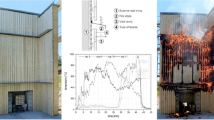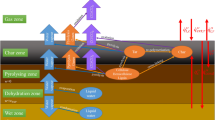Abstract
In this paper, by employing ANSYS Workbench software and three-dimensional finite element simulation, the damage of fire insulated composite sandwich panels subjected to fire and impact loads is estimated. Also, an innovative method was introduced to protect composite sandwich panels with high exposure risk of fire and impact simultaneously. For this purpose, at first, the structure is subjected to impact of a projectile disk and the damage caused in the structure is estimated. Later, the structure is subjected to heat of the fire caused by hydrocarbon fuel. To demonstrate the validity and precision of the presented simulations, the obtained results are compared with the experimental and numerical results presented in the available literature. In all simulations, the properties of the laminated composite skins and core foam are temperature dependent. This research shows some practical results that can be helpful for design of composite sandwich panels with the risk of exposing fire and impact loads.























Similar content being viewed by others
References
Anjang A, Chevali VS, Kandare E, Mouritz AP, Feih S (2014) Tension modelling and testing of sandwich composites in fire. Compos Struct 113:437–445
Anjang A, Chevali VS, Lattimer BY, Case SW, Feih S, Mouritz AP (2015) Post-fire mechanical properties of sandwich composite structures. Compos Struct 132:1019–1028
Anjang A, Chevali VS, Feih S, Mouritz AP (2016) Deterioration of the fire structural resistance of sandwich composite under tension due to water absorption. Compos Part A 87:263–270
Asaro RJ, Lattimer B, Ramroth W (2009) Structural response of FRP composites during fire. Compos Struct 87:382–393
Bai Y, Keller T (2007) Modeling of post-fire stiffness of E-glass fiber-reinforced polyester composites. Compos Part A 38:2142–2153
Bai YU, Keller T (2009) Modeling of strength degradation for fiber-reinforced polymer composites in fire. J Compos Mater 43:2371–2385
Birman V, Kardomateas GA, Simitses GJ, Li R (2006) Response of a sandwich panel subject to fire or elevated temperature on one of the surfaces. Compos Part A 37:981–988
Clegg RA, White DM, Riedel W, Harwick W (2006) Hypervelocity impact damage prediction in composites: part I—material model and characterization. Int J Impact Eng 33:190–200
Feih S, Mathys Z, Gibson AG, Mouritz AP (2007a) Modelling the compression strength of polymer laminates in fire. Compos Part A 38:2354–2365
Feih S, Mathys Z, Gibson AG, Mouritz AP (2007b) Modelling the tension and compression strengths of polymer laminates in fire. Compos Sci Technol 67:551–564
Feih S, Mathys Z, Gibson AG, Mouritz AP (2008) Modeling compressive skin failure of sandwich composites in fire. J Sandw Struct Mater 10:217–245
Feih S, Mouritz AP, Mathys Z, Gibson AG (2010) Fire structural modeling of polymer composites with passive thermal barrier. J Fire Sci 28:141–160
Galgano A, Blasi CD, Branca C, Milella E (2009) Thermal response to fire of a fibre-reinforced sandwich panel: model formulation, selection of intrinsic properties and experimental validation. Polym Degrad Stab 94:1267–1280
Galgano A, Blasi CD, Milella E (2010) Sensitivity analysis of a predictive model for the fire behavior of a sandwich panel. Polym Degrad Stab 95:2430–2444
Gu P, Asaro RJ (2009) Designing sandwich polymer matrix composite panels for structural integrity in fire. Compos Struct 88:461–467
Gu P, Dao M, Asaro RJ (2009) Structural stability of polymer matrix composite panels in fire. Mar Struct 22:354–372
Henderson JB, Wiebelt JA, Tant MR (1985) A model for the thermal response of polymer composite materials with experimental verification. J Compos Mater 19:579–595
Kandare E, Griffin GJ, Feih S, Gibson AG, Lattimer BY, Mouritz AP (2012) Fire structural modelling of fibre–polymer laminates protected with an intumescent coating. Compos Part A 43:793–802
Kardomateas GA, Simitses GJ, Birman V (2009) Structural integrity of composite columns subject to fire. J Compos Mater 43:1015–1033
Kim M, Choe J, Lee DG (2017) Development of the fire-retardant sandwich structure using an aramid/glass hybrid composite and a phenolic foam-filled honeycomb. Compos Struct 158:227–234
Lua J (2011) Hybrid progressive damage prediction model for loaded marine sandwich composite structures subjected to a fire. Fire Technol 47:851–885
Luo Ch, Lua J, DesJardin PE (2012) Thermo-mechanical damage modeling of polymer matrix sandwich composites in fire. Compos Part A 45:814–821
Mouritz AP, Gardiner CP (2002) Compression properties of fire-damaged polymer sandwich composites. Compos Part A 33:609–620
Mouritz AP, Gibson AG (2006) Fire properties of polymer composite materials. Springer, Berlin
Mouritz AP, Mathys Z (1999) Post-fire mechanical properties of marine polymer composites. Compos Struct 47:643–653
Mouritz AP, Mathys Z (2000) Mechanical properties of fire-damaged glass-reinforced phenolic composites. Fire Mater 24:67–75
Saldi ZS, Wen JX (2017) Modeling thermal response of polymer composite hydrogen cylinders subjected to external fires. Int J Hydrogen Energy 42:7513–7520
Selahi E (2016) Strength, performance and modeling of composite structures subjected to fire. Islamic Azad University,Marvdasht Branch Publications, Iran (In Persian)
Selahi E, Sepehri A, Rajab I, Dehghanian A (2012) Transient thermo-mechanical modeling of insulated composite sandwich panels under combined fire and shock loadings. In: 20th Annual international conference on mechanical engineering (ISME2012), Shiraz University, Shiraz, Iran,
Shokrieh MM, Abdolvand H (2011) Three-dimensional modeling and experimental validation of heat transfer in polymer matrix composites exposed to fire. J Compos Mater 45:1953–1965
Zhang Y, Wanga YC, Bailey CG, Taylor AP (2012) Global modelling of fire protection performance of intumescent coating under different cone calorimeter heating conditions. Fire Saf 50:51–62
Ziqing Y, Aixi Z (2009) Modeling of composite panel under fire and compression. American Composites Manufacturers Association, Composites and Polycon, Tampa
Author information
Authors and Affiliations
Corresponding author
Rights and permissions
About this article
Cite this article
Sepehri, A., Selahi, E. Damage Evaluation of Protected and Non-protected Composite Sandwich Panels with Insulation Subjected to Fire and Impact Loads. Iran J Sci Technol Trans Mech Eng 44, 333–345 (2020). https://doi.org/10.1007/s40997-018-0276-4
Received:
Accepted:
Published:
Issue Date:
DOI: https://doi.org/10.1007/s40997-018-0276-4




